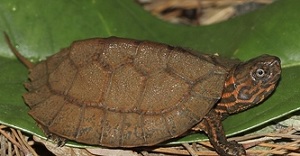Asian Leaf Turtle (Cyclemys dentata)
Classification: Introduced Species - While the Asian Leaf Turtle has been seen and identified in the state of Massachusetts, there are no records of any breeding populations. Sightings of this species are most likely of released or escaped pets that were imported for the pet trade.
Description: Asian leaf turtles have an oval-shaped carapace (shell) on their back which is colored dark brown. At its rear the edges are serrated and raised keels are present along the center. Overall the shell is flat. The underside of the shell, known as the plastron is patterned with radiating lines. The head of the Asian leaf turtle is colored reddish brown. Their legs are colored light or reddish brown. Their feet are semi-webbed, an adaptation which allows these animals to be successful swimmers. An average Asian leaf turtle measures between 6 to 9.6 inches long with a weight of 3.3lbs. Males tend to be smaller than females though their tail is thicker than that of females. Their shell may measure 4.5 to 6.5inches across.
Habitat: Asian leaf turtles will make their home in forests and wetlands. They spend much of their time in water including streams, swamps and wetlands. Their habitat is regularly converted to palm oil plantations but these are too open and dry to act as suitable habitat for the species.
Range: Identified in Massachusetts. The turtle can be found in North India, North-east India (Manipur), Bangladesh, Myanmar (Burma), Thailand, Cambodia, Vietnam, West Malaysia, Indonesia (Sumatra, Java, Borneo, Bali), Philippines (Palawan: Calamian Islands etc.), and China. This species is found up to 3600 feet of elevation, but the depth range is unknown.
Found in these States:
MA
Diet: This species is omnivorous and feeds on vegetation and fruits, and also mollusks, crustaceans and fish. It is also known to be scavenger and very often seen to take carrion.
Reproduction: Each year they may produce as many as 5 clutches of eggs with between 2 and 4 eggs in clutch. Females will dig a chamber in to which these eggs can be deposited. To allow the female to lay her eggs the plastron will become flexible. Their eggs hatch after a 2.5 month incubation period. Hatchlings are equipped with spines around the edge of the carapace which are thought to deter predators.
Status: IUCN has them designated as Near Treatened.
»» Kingdom: Animalia - Animals
»» Phylum: Chordata - Chordates
»» Subphylum: Vertebrata - Vertebrates
»» Class: Reptilia - Reptiles
»» Order: Testudines - Turtles & Tortoises
»» Family: Geoemydidae - Leaf Turtles
»» Genus: Cyclemys
»» Species: Cyclemys dentata - Asian Leaf Turtle
»» Subspecies: None
This article uses material from the Wikipedia article "Asian Leaf Turtle", which is released under the Creative Commons Attribution-Share-Alike License 3.0. Content may have been omitted from the original, but no content has been changed or extended.
|







